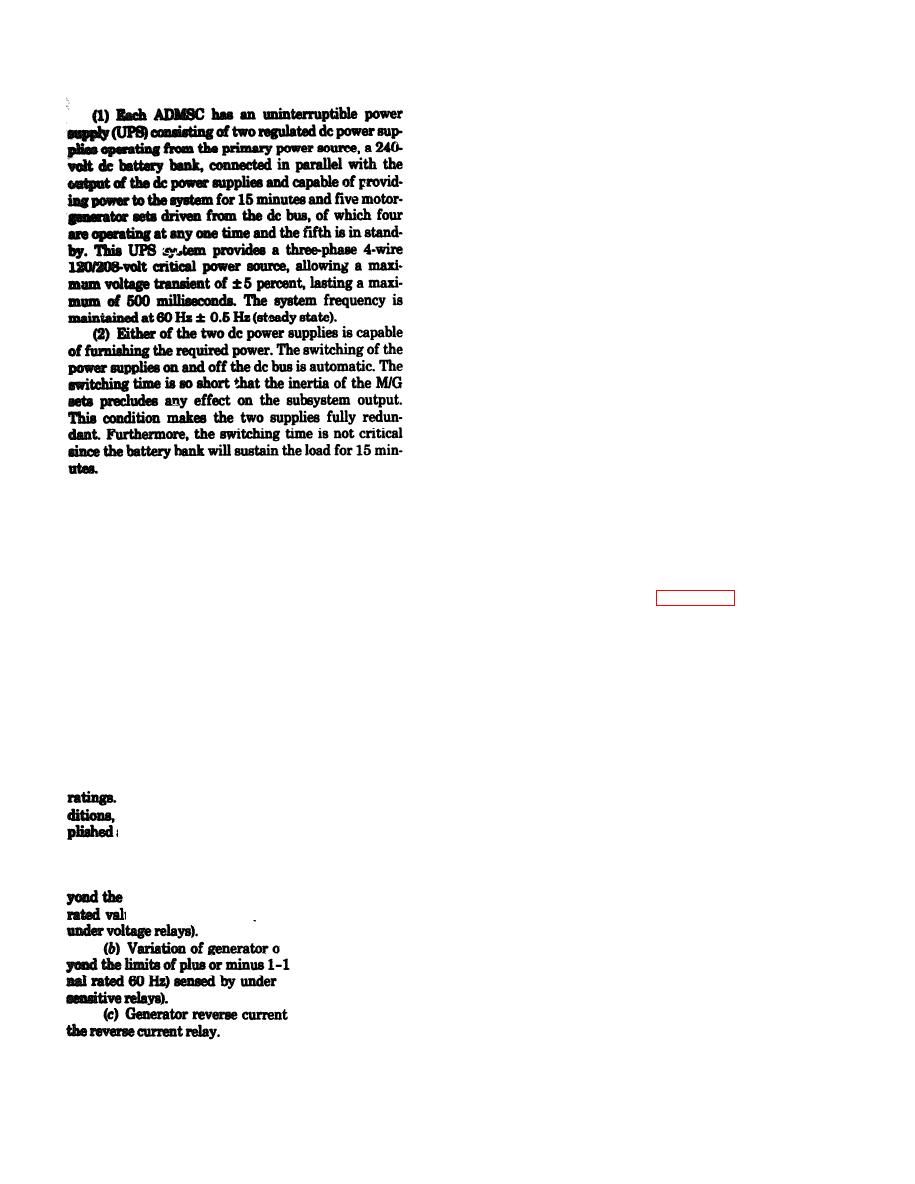 |
|||
|
|
|||
|
|
|||
| ||||||||||
|
|
 TM 11-5895-1012-10
(6) The following controls are built into the UPS
to maintain the stabilized power required for the
ADMSC:
(a) Frequency Regulation. The magnetic ampli-
fier type of speed regulator is provided with the dc
motor of each motor-generator unit for controlling the
M/G set speed, which in turn controls the output fre-
quency. These speed regulators offer the advantages of
high corrective output signal (high gain) from a
relatively low level input with associated fact response
to variations in the M/G set speed (frequency). The
speed regulating system consists of a frequency detec-
tor, magnetic amplifier control circuit, and a single
phase full-wave magnetic amplifier which controls
excitation of the dc motor.
voltage of each motor-generator unit is controlled by
an individual magnetic amplifier type of voltage
regulator.
(c) Additional Controls. In addition to the above
controls, each motor-generator set contains associated
under and over voltage relays, and reverse current re-
lays to monitor operation properly. Activation of any
(3) The battery bank consists of 120 2-volt single-
of these relays will energize the trip circuits of the in-
cell units connected in series.
put and output circuit breakers and remove the as-
(4) There are four motor-generator units operat-
sociated M/G set from the UPS system.
ing at any time, but a total of five units are available
c. Another method for providing uninterruptible
for operation. In case one of the operating units fails,
power to critical loads is the solid-state static-type
the stan.dby unit is automatically turned on,
synchronized, and switched on the line within 10 sec-
rectifier-charger-battery-inverter system shown by the
simplified system block diagram in figure 2-14. This
onds. The UPS is designed so that, under normal op-
is a modularized redundant system each module con-
erating conditions (four units on-line), each M/G set is
sisting of a rectifier-charger unit, a battery (usually
operating at approximately 60 percent of rated load.
selected for 15-minute output), and an inverter unit to-
Since the units are rated for a 25 percent overload last
gether with appropriate protective devices. Each mod-
ing at least two hours, the UPS system is capable of op-
ule has a 100 kilowatt (KW), 125 kilovolt-ampere
erating with only two functioning M/G sets for brief
periods, and with three sets for indefinite periods.
(Kva) output rating.
(1) The unit is designed for 200 kilowatt output.
This degree of redundance provides the critical por-
tions of the ADMSC with great reliability.
Normally the 200 kilowatt rated load is divided equal-
(5) Under normal operating conditions, four M/G
ly between the three 125 Kva units. In case of failure
of any one unit, the unit that has malfunctioned is
sets are connected to the critical supply bus and are
automatically removed from operation and the 200
equally dividing the system load within their normal
Based on these normal system operating con-
K W load is divided equally between the two remaining
an automatic power load transfer is accom-
units. Being modular constructed, the module that
at the no-break critical supply bus as a result of
failed can be de-energized, the trouble located, and a
one or more of the following abnormal operating sys-
new component inserted in the circuitry.
tem conditions:
(2) Since this type of UPS has limited operating
(a) Variation of generator output voltage be-
experience, records of performance so far have indi-
limits of plus or minus 10 percent of normal
cated a mean-time-between-failure (MTBF) to be antic-
ue of 120/208 volts (sensed by the over and
ipated on the order of 80,000 hours.
2-29. Miscellaneous Power Equipment
utput frequency be-
/2 Hz of the nomi-
a. Storage Batteries. Storage batteries provide a
and over frequency
compact source of dc power for the operation of equip
ment requiring a dc source with a DCS Station.
flow as sensed by
b. Dry Batteries. Dry batteries are used by DCS Sta-
tions to furnish power for certain alarm circuits, emer
|
|
Privacy Statement - Press Release - Copyright Information. - Contact Us |